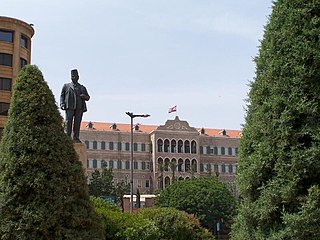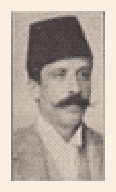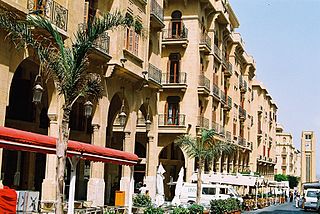Related Research Articles

The Parliament of Lebanon is the national parliament of Lebanon. There are 128 members elected to a four-year term in multi-member constituencies, apportioned among Lebanon's diverse Christian and Muslim denominations but with half of the seats reserved for Christians per Constitutional Article 24. Lebanon has universal adult suffrage. Its major functions are to elect the President of the republic, to approve the government, and to approve laws and expenditure.

Martyrs' Square, historically known as "Al Burj" or "Place des Cannons", is the historical central public square of Beirut, Lebanon.

The Grand Serail is the headquarters of the Prime Minister of Lebanon. It is situated atop a hill in downtown Beirut a few blocks away from the Lebanese Parliament building. The Grand Serail is a historic building, the most important of three Ottoman monuments on the Serail hill. The other two are the Council for Development and Reconstruction and the Hamidiyyeh clock tower. This historic building has earned its importance through successive roles which it held since 1832

Te Ngākau Civic Square is a public square in central Wellington, New Zealand, between the Wellington central business district to the north and the Te Aro entertainment district to the south.

Bourj Hammoud is a town and municipality in Lebanon located north-east of the capital Beirut, in the Matn District, and is part of Greater Beirut. The town is heavily populated by Armenians.

The Beirut Central District (BCD) or Centre Ville is the historical and geographical core of Beirut, the capital of Lebanon. Also called downtown Beirut, it has been described the “vibrant financial, commercial, and administrative hub of the country.” It is thousands of years old, traditionally a focus of business, finance, culture and leisure.

The Central Embarcadero Piers Historic District is a Registered Historic District in the City of San Francisco, California, United States. It consists of Piers 1, 1½, 3 and 5, is one of the largest surviving pier complexes along San Francisco's Embarcadero. The Central Embarcadero Piers Historic District was added to the National Register of Historic Places on November 20, 2002.

Youssef Aftimus ; was a Lebanese civil engineer and architect who specialized in Moorish Revival architecture. Aftimus was the leading Lebanese architect and urban planner during the first half of the twentieth century, he is the author of many of Beirut's well known landmarks such as the Beirut Municipality Building, the Grand Serail's Hamidiyyeh clock tower, the Hamidiyyeh Fountain and the Barakat Building. Aftimus was also an academic, journalist, visionary urban planner, patriot, politician and philanthropist.

Nabil Gholam is a Lebanese architect, urban planner and the founder of Nabil Gholam Architects (ngª). In 2010, Monocle magazine has called Gholam a "leading" Lebanese architect. In Modern Architecture: A Critical History, critic Kenneth Frampton cited Gholam's colony of holiday chalets at Faqra as one of "two works [which] promise a renewal of Lebanese architecture".

Beirut Souks is a major commercial district in Beirut Central District. With over 200 shops, 25 restaurants and cafes, an entertainment center, a 14 cinema complex, periodic street markets and an upcoming department store, it is Beirut's largest and most diverse shopping and leisure area. Beirut Souks also features piazzas and public space. Designed in five separate commissions by international and Lebanese architects, Beirut Souks offer 128,000 sq. m of built-up area interspersed with landscaped pedestrian zones.
Gaby Emile Layoun was the Lebanese Minister of Culture, announced as part of the cabinet led by Najib Mikati. He represents the Free Patriotic Movement. Layoun is married and has two children. He holds a diploma in engineering, a Lebanese Baccalaureate in mathematics (1982) and a Sacred Heart of the city of Zahle.

Rue Maarad is a street in Beirut, Lebanon. The street was conceived during the French Mandate period as a central commercial street radiating from Etoile Square. Its arched façades were inspired by the ‘Rue de Rivoli’ in Paris.

The Petit Serail was a historic administrative Ottoman building in Beirut that housed the seat of the Wali of Syria and Beirut. It was situated to the northern side of Martyrs' Square at the heart of the Beirut Central District. The building was the scene of important historical events, but plans to enlarge Beirut's main square led to its destruction in 1950. It was one of several Ottoman era building projects that shaped the architecture of Lebanon in Beirut.

Beirut City Hall, also known as the Municipality of Beirut, is a landmark building built in downtown Beirut, Lebanon in 1924, and has become an architectural landmark in the downtown area of Beirut Central District. It features a yellow limestone facade and combines various architectural styles. The building is located on the intersection of Foch Street and Rue Weygand in the city center. The building is in the Venetian and Arabesque architectural styles, a mix that expresses the regional identity of the area. The building was restored after the Lebanese Civil War and it currently houses the office of the Governor of Beirut and the municipal council. It is open to the public and for official registration of documents.
The Master Plan, completed and approved in 1994, set up the guidelines for the conservation and restoration of some 291 buildings identified as buildings to be preserved and restored.
Harbor Square is a square in Beirut, Lebanon.

The Emir Assaf Mosque is a mosque located in downtown Beirut, Lebanon.
Phoenico-Persian Quarter is located in Beirut, Lebanon.
Foch Street is located in Beirut, Lebanon.
The Beirut Heritage Trail is a project undertaken by Solidere with the support of the Ministry of Culture and the Municipality of Beirut. Marked out by bronze medallions grouted into the sidewalk, the trail will link archeological sites, historic public spaces and heritage buildings over a 2.5 km walking circuit in the historic core of Beirut.
References
{{Kassir, Samir (2003) Histoire de Beyrouth, Fayard, Paris.
Saliba, Robert (2004) Beirut City Center Recovery: The Foch-Allenby and Etoile Conservation Area, Steidel, Göttingen.}}